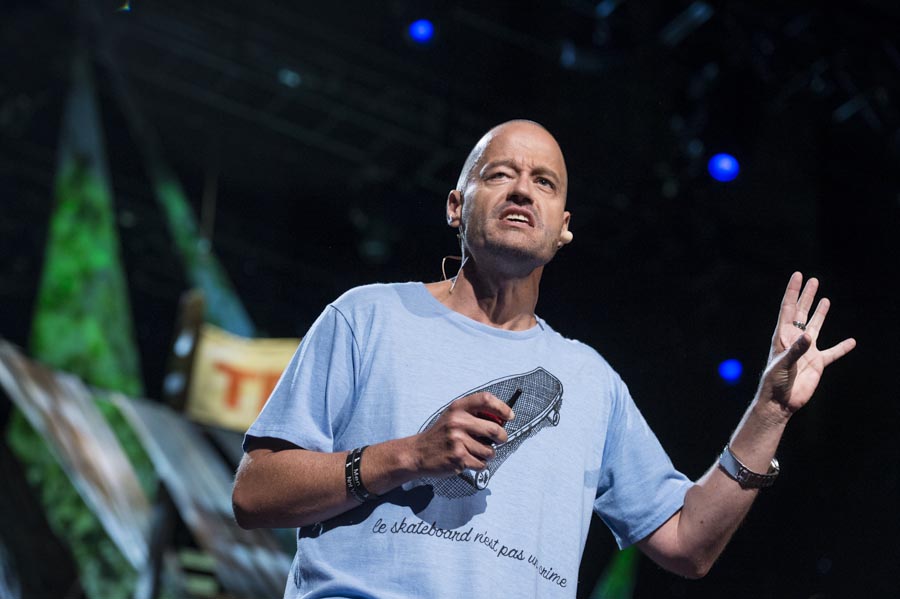Adam Spencer is a radio host in in Sydney during the morning commute. But he says he’s here not as a radio host or as a comedian, “But as someone who is was and always will be a mathematician.”
He got bit in second grade when a teacher told him, “That would be like putting a square peg in a round hole.” He said, not trying to be funny, “But Miss, surely if the diameter of the square is less than the diameter of the circle, then surely the square peg will go straight through the round hole.” Silence until his friend leaned over and punched him in the head. That punch was meant to send a message — the world was branching into two paths and he had to make a decision. “I took a look at the road map of life, and ran off down the street marked GEEK as fast as my chubby, asthmatic legs woud take me.”
Spencer explains his love of mathematics: “Numbers are the notes with which the symphony of the universe is written.” Today, his goal is to show us some of the most beautiful notes. For him, those are the prime numbers. Most of us remember that 6 isn’t prime, while 7 is, because 6 is the product of two smaller numbers, 2 and 3, while 7 isn’t. There are two things Spencer wants us to know about primes: 1 is not a prime (“Proving that fact is a great party trick. At the right party.”), and there are an infinite number of them.
Despite the fact that there are infinitely many primes, mathematicians at any point in history want to know: What is the biggest prime we know? Now he’s going to do some math, but, “Don’t. freak. out.” Just remember that 25 is 2x2x2x2x2.
It turns out most of the giant primes we know take the form 2(prime number) -1. Not all of them, 211-1 is not prime, but 213-1, 217-1, and 219-1 are. “Then they thin out.”
Over the years, many have searched for primes like these. In 1876, 2127-1 was proven to be prime, an accomplishment that earned Edouard Lucas a place on European currency, “Back when that was a compliment.”
It can also be dramatic to show that a number is not prime. For decades, mathematician knew that 267-1 was not prime, but didn’t know the factors. In 1903 at a major mathematics meeting, Frank Nelson Cole walked up to the board and started writing. He never said a word, just multiplied the numbers out, showing that he had factored the number. The room went wild.
 Computers, of course, changed everything. By 1996 2^1,398,269-1 was known to be prime. Most recently, in fact so recently Spencer had to change is talk because of it, Curtis Cooper found that 257,885,161-1 was prime. That number is 17,425,170 digits long, and would be one and a half times the length of the Harry Potter novels if you wrote it out.
Computers, of course, changed everything. By 1996 2^1,398,269-1 was known to be prime. Most recently, in fact so recently Spencer had to change is talk because of it, Curtis Cooper found that 257,885,161-1 was prime. That number is 17,425,170 digits long, and would be one and a half times the length of the Harry Potter novels if you wrote it out.
What comes through so clearly in the talk is just how excited Spencer is about this. He says, “We know this is prime as confidently as we know the number seven is prime. That fills me with almost sexual excitement, and who am I kidding when I say almost.”
Why do we care about this? There are practical uses of primes in cryptography and testing microchips, but for Spencer it’s much more. Currently the searches are done as a large networked hunt, with many people and computers participating. “This is a metaphor for the time in which we live,” says Spencer, “When human minds and machines can conquer together… How lucky are we to live in this age when mind and machine can work together.”
It is inspirational, because, like the Higgs Boson and many other scientific voyages of discovery, “We thought it might be there and we went and found it.”
Adam Spencer’s talk is now available for viewing. Watch it on TED.com »

Comments (8)
Pingback: The best of the web | My Favorite 31 Talks From TED 2013
Pingback: Adam Spencer: Why I fell in love with monster prime numbers – [TED Talks] | mostly music
Pingback: Hunting Monster Primes | Memecoder
Pingback: TED 2013: 9 Take-Home Themes for Me
Pingback: Wizmo Blog » Blog Archive » Hunting monster primes: Adam Spencer at TED2013